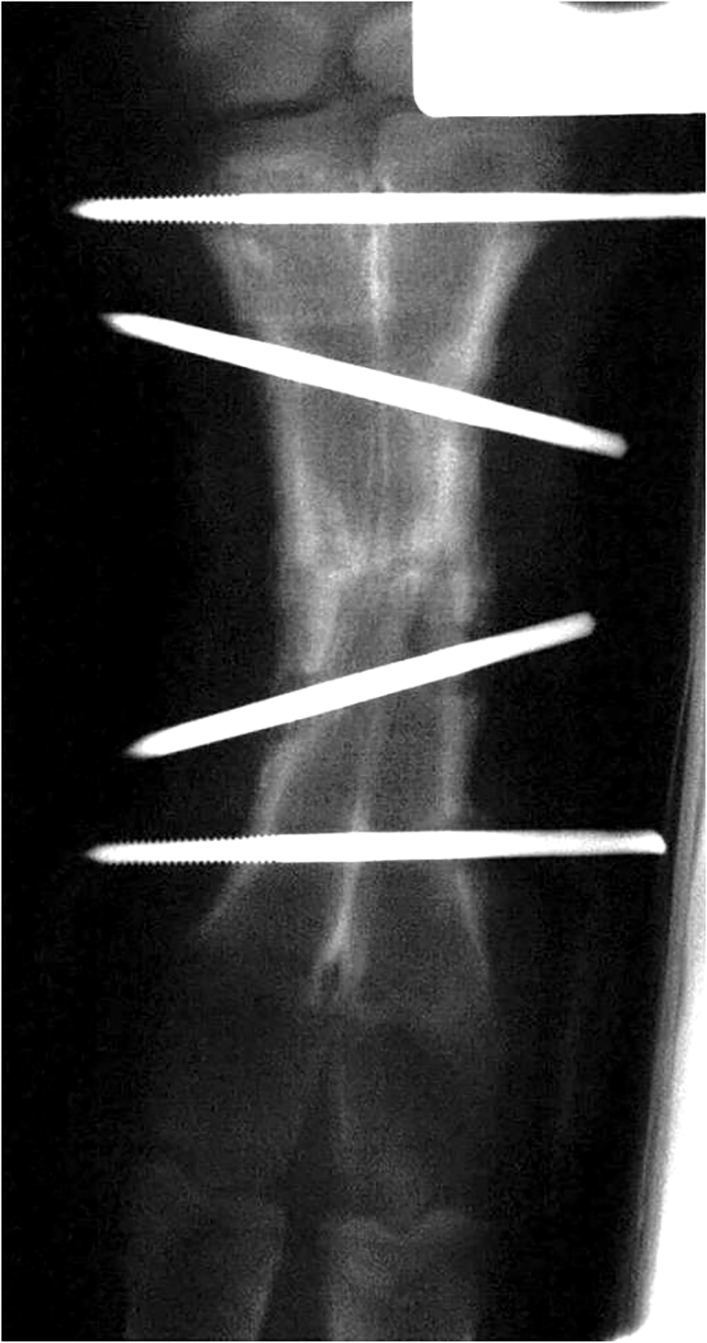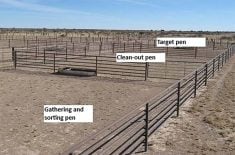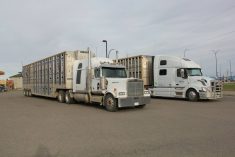Fractured legs are relatively common in young or newborn calves, mostly due to accidental stepping by cows.
Dr. Andy Acton of Deep South Animal Clinic at Ogema, Sask., says age of the calf, whether it’s a front or back leg, and location of the fracture determine how easily it can be immobilized for healing.
Broken legs from calving chains, when too much pressure is applied, are easily prevented by proper positioning of chains, straps or ropes.
“Some of those fractures won’t heal because the blood supply has been damaged and the chances for a good repair are lower; there is risk for losing the foot,” he says, noting one case in which both front legs were broken because there was only one loop on each foot. The owner found it impossible to deliver the calf.
“We did a caesarean and got the calf out alive, put casts on both front legs, and luckily they both healed,” says Acton.
In other broken leg cases, repairs are questionable when the skin is broken or bone is exposed. That brings a high risk for infection and lower chance for adequate healing. Some of these calves may need to be euthanized.
“If a bone is coming through the skin, we may still try to cast the leg but a high percentage of these develop infections that may keep them from healing. The prognosis is not as good. The result may depend on how much time the producer wants to commit to, for care and treatment, and the relative value of that calf,” Acton says.
“We assess the fracture and might use radiographs, depending on where it is. If it’s low and close to a joint, we’ll use an X-ray to determine whether the joint is involved. This also gives us more idea what the outcome might be.
“If it is a higher fracture, a radiograph might guide us in how to repair it. If it’s a cannon bone fracture on a front or back leg, it may need just a simple cast that goes high enough to immobilize the joint above the break.”
Acton says a normal cast may not be used on a fracture that is high on the leg, which is more difficult to immobilize. Treatment can thus be more costly.
If producers are far from a clinic, they may to try to immobilize the break with a splint until the calf can be seen by the veterinarian.
“It’s usually better to not try to splint them for long-term, but a temporary splint may be helpful until you can get the calf to a veterinarian. I don’t discourage anyone from trying to immobilize the leg, but it needs to be done correctly or may do more harm than good,” Acton says.
A thick magazine, secured with duct tape, or a PVC pipe cut lengthwise and padded, are good options for temporary splints. A towel can be wrapped around the leg to pad it. A splint might keep the bone from coming through the skin, providing support and protection until a cast can be created.
“We get lots of calves brought in that are not splinted, however, and they usually do fine after we cast them. The type of fracture most worrisome would be a long-angled break with a shard of bone under the skin. Sometimes when a producer tries to create a splint, a break that hadn’t perforated may come through,” he says.
Newborns with broken legs should be given colostrum before coming to the vet.
Femur fractures between hip and stifle, and breaks in the humerus between shoulder and elbow, are uncommon and difficult to treat but can heal. The humerus can sometimes be left to heal on its own, and in some cases the femur can heal if the animal doesn’t have to walk around and its muscling is thick enough to hold the femur in place, Acton says.
This works best on an older calf. A newborn usually doesn’t have enough muscle.
Cannon bone fractures are fairly simple.
“We use a fibreglass cast high enough to immobilize it. On the tibia or radius, if the fracture is too high up the bone, we use a version of the Thomas splint or a Thomas-Schroeder splint,” says Acton.
It looks like a crutch that goes beneath the armpit or groin and is attached to the hoof.
“These can be made using light pipe or aluminum as a frame. We used to weave this in place with tape, but we don’t do that anymore because there is too much room for possible movement, rubbing too much, or needing to be redone several times. We now use cast material supported by the splint, and most of those calves do fine,” he says.
If the fracture is low on the radius or tibia, a pin cast can be used. Two pins are driven horizontally into the bone above the break to create an anchoring site to hold a cast in place.
“There’s also a lateral splint — making a high cast and using the outside of it to try to immobilize some of the higher tibia fractures. A little handier than a big Thomas splint.”
For small calves, a big dog splint, shaped to fit a hind leg, with a bend for the hock, can immobilize a break above the hock. The leg is wrapped and padded with roll cotton and the splint is put on the outside and taped securely in place.
“With a normal fracture and cast, sometimes we need to replace the first cast in a couple weeks or so to allow for the growing leg but often we just use the original cast. It can be removed by the producer, using wires we put in the cast, splitting it lengthwise, then put back on as a splint, using duct tape,” says Acton.
“It’s already formed to the leg. It can be taken off before it creates significant sores and re-use it as a splint,” he says. “This continues to support the leg for another week or 10 days and is better than having to use two full casts, two anesthetic procedures and two sessions at the veterinary clinic.”
Back at the farm, the animal should be confined in a small, dry area.
“A fibreglass cast can withstand some moisture but none of these casts should get really wet,” says Acton.
He says it is more difficult to treat broken legs in older and larger cattle.
“Cannon bone fractures are fairly simple on babies, but larger calves have a harder time dealing with a cast all the way up the leg, which is usually necessary because they are so much heavier,” he says.
“We may use a pin cast on a low cannon bone fracture. We can put two pins through the cannon bone to secure it and have a much shorter cast, making it easier for the animal to get around. There is basically only one joint that must be immobilized, below the knee or hock, so the knee or hock can bend normally. They can get around fairly well and don’t put as much stress on the cast.”

“We’ve had some cases we had to cast clear up to the elbow or stifle cast on a bigger calf to provide the needed support.”
Temperament is a big factor in prognosis, he adds.
“With a serious fracture on a 700-pound calf that’s wild and hard to handle, it is probably best just to butcher and salvage that animal. But with small calves we can handle them and make it work.”
He recalls an interesting case from a few years ago.
“She was a 1,500-lb. Shorthorn show heifer and we made her a Thomas splint, using 27 rolls of fibreglass cast material. She healed nicely and is still walking around, and her owners flushed embryos from her. They did an amazing job taking care of her at home while that leg was healing.”
The bone didn’t heal perfectly and the cow walks oddly but gets around well, says Acton. It went on to raise many calves and has descendants on three continents.

















